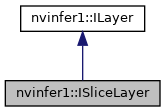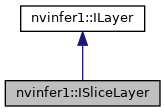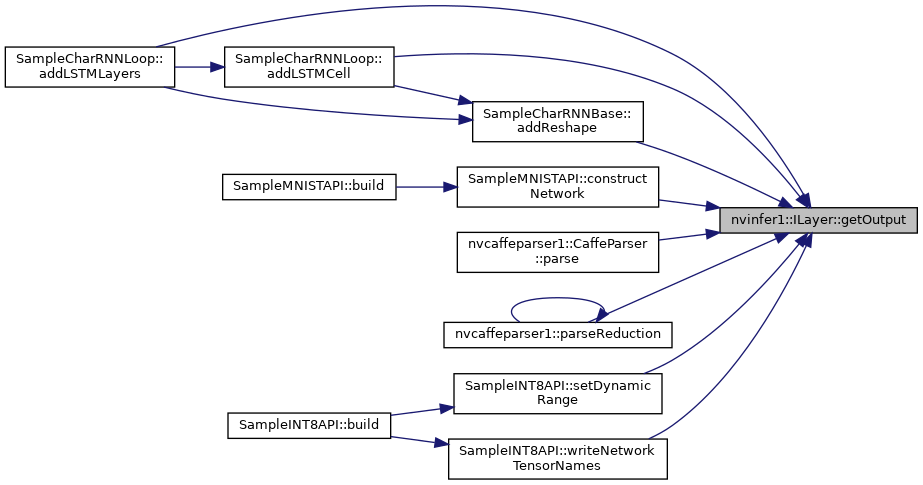Slices an input tensor into an output tensor based on the offset and strides. More...


Public Member Functions | |
| virtual void | setStart (Dims start)=0 |
| Set the start offset that the slice layer uses to create the output slice. More... | |
| virtual Dims | getStart () const =0 |
| Get the start offset for the slice layer. More... | |
| virtual void | setSize (Dims size)=0 |
| Set the dimensions of the output slice. More... | |
| virtual Dims | getSize () const =0 |
| Get dimensions of the output slice. More... | |
| virtual void | setStride (Dims stride)=0 |
| Set the stride for computing the output slice data. More... | |
| virtual Dims | getStride () const =0 |
| Get the stride for the output slice. More... | |
| virtual void | setMode (SliceMode mode)=0 |
| Set the slice mode. More... | |
| virtual SliceMode | getMode () const =0 |
| Get the slice mode. More... | |
| void | setInput (int32_t index, ITensor &tensor)=0 |
| Append or replace an input of this layer with a specific tensor. More... | |
| virtual LayerType | getType () const =0 |
| Return the type of a layer. More... | |
| virtual void | setName (const char *name)=0 |
| Set the name of a layer. More... | |
| virtual const char * | getName () const =0 |
| Return the name of a layer. More... | |
| virtual int32_t | getNbInputs () const =0 |
| Get the number of inputs of a layer. More... | |
| virtual ITensor * | getInput (int32_t index) const =0 |
| Get the layer input corresponding to the given index. More... | |
| virtual int32_t | getNbOutputs () const =0 |
| Get the number of outputs of a layer. More... | |
| virtual ITensor * | getOutput (int32_t index) const =0 |
| Get the layer output corresponding to the given index. More... | |
| virtual void | setPrecision (DataType dataType)=0 |
| Set the computational precision of this layer. More... | |
| virtual DataType | getPrecision () const =0 |
| get the computational precision of this layer More... | |
| virtual bool | precisionIsSet () const =0 |
| whether the computational precision has been set for this layer More... | |
| virtual void | resetPrecision ()=0 |
| reset the computational precision for this layer More... | |
| virtual void | setOutputType (int32_t index, DataType dataType)=0 |
| Set the output type of this layer. More... | |
| virtual DataType | getOutputType (int32_t index) const =0 |
| get the output type of this layer More... | |
| virtual bool | outputTypeIsSet (int32_t index) const =0 |
| whether the output type has been set for this layer More... | |
| virtual void | resetOutputType (int32_t index)=0 |
| reset the output type for this layer More... | |
Protected Member Functions | |
| virtual | ~ISliceLayer () |
Slices an input tensor into an output tensor based on the offset and strides.
The slice layer has two variants, static and dynamic. Static slice specifies the start, size, and stride dimensions at layer creation time via Dims and can use the get/set accessor functions of the ISliceLayer. Dynamic slice specifies one or more of start, size or stride as ITensors, by using ILayer::setTensor to add a second, third, or fourth input respectively. The corresponding Dims are used if an input is missing or null.
An application can determine if the ISliceLayer has a dynamic output shape based on whether the size input (third input) is present and non-null.
The slice layer selects for each dimension a start location from within the input tensor, and copies elements to the output tensor using the specified stride across the input tensor. Start, size, and stride tensors must be 1D Int32 shape tensors if not specified via Dims.
Furthermore, if the slice layer must produce a shape tensor, then start, size, and stride must be build time constants, i.e. as static Dims, or be computable by constant folding.
For example using slice on a tensor: input = {{0, 2, 4}, {1, 3, 5}} start = {1, 0} size = {1, 2} stride = {1, 2} output = {{1, 5}}
|
inlineprotectedvirtual |
|
pure virtual |
Set the start offset that the slice layer uses to create the output slice.
| start | The start offset to read data from the input tensor. |
If the second input is set, it is reset to null.
|
pure virtual |
|
pure virtual |
Set the dimensions of the output slice.
| size | The dimensions of the output slice. |
If the third input is set, it is reset to null.
|
pure virtual |
|
pure virtual |
Set the stride for computing the output slice data.
| stride | The dimensions of the stride to compute the values to store in the output slice. |
If the fourth input is set, it is reset to null.
|
pure virtual |
|
pure virtual |
Set the slice mode.
|
pure virtual |
Get the slice mode.
|
pure virtual |
Append or replace an input of this layer with a specific tensor.
| index | the index of the input to modify. |
| tensor | the new input tensor |
For a slice layer, the values 0-3 are valid. The values 1-3 override start, size or stride dimensions, respectively. Conversely, this input tensor can be overridden via appropriate set call. The indices are as follows:
If this function is called with a value greater than 0, then the function getNbInputs() changes from returning 1 to index + 1.
Implements nvinfer1::ILayer.
|
pure virtualinherited |
Return the type of a layer.
|
pure virtualinherited |
Set the name of a layer.
This method copies the name string.

|
pure virtualinherited |
|
pure virtualinherited |
Get the number of inputs of a layer.
|
pure virtualinherited |
Get the layer input corresponding to the given index.
| index | The index of the input tensor. |
|
pure virtualinherited |
Get the number of outputs of a layer.

|
pure virtualinherited |
Get the layer output corresponding to the given index.

|
pure virtualinherited |
Set the computational precision of this layer.
Setting the precision allows TensorRT to choose implementation which run at this computational precision. Layer input type would also get inferred from layer computational precision. TensorRT could still choose a non-conforming fastest implementation ignoring set layer precision. Use BuilderFlag::kSTRICT_TYPES to force choose implementations with requested precision. In case no implementation is found with requested precision, TensorRT would choose available fastest implementation. If precision is not set, TensorRT will select the layer computational precision and layer input type based on performance considerations and the flags specified to the builder.
| precision | the computational precision. |
|
pure virtualinherited |
get the computational precision of this layer
|
pure virtualinherited |
whether the computational precision has been set for this layer
|
pure virtualinherited |
reset the computational precision for this layer
|
pure virtualinherited |
Set the output type of this layer.
Setting the output type constrains TensorRT to choose implementations which generate output data with the given type. If it is not set, TensorRT will select output type based on layer computational precision. TensorRT could still choose non-conforming output type based on fastest implementation. Use BuilderFlag::kSTRICT_TYPES to force choose requested output type. In case layer precision is not specified, output type would depend on chosen implementation based on performance considerations and the flags specified to the builder.
This method cannot be used to set the data type of the second output tensor of the TopK layer. The data type of the second output tensor of the topK layer is always Int32. Also the output type of all layers that are shape operations must be DataType::kINT32, and all attempts to set the output type to some other data type will be ignored except for issuing an error message.
Note that the layer output type is generally not identical to the data type of the output tensor, as TensorRT may insert implicit reformatting operations to convert the former to the latter. Calling layer->setOutputType(i, type) has no effect on the data type of the i-th output tensor of layer, and users need to call layer->getOutput(i)->setType(type) to change the tensor data type. This is particularly relevant if the tensor is marked as a network output, since only setType() [but not setOutputType()] will affect the data representation in the corresponding output binding.
| index | the index of the output to set |
| dataType | the type of the output |
|
pure virtualinherited |
get the output type of this layer
| index | the index of the output |
|
pure virtualinherited |
whether the output type has been set for this layer
| index | the index of the output |
|
pure virtualinherited |
reset the output type for this layer
| index | the index of the output |